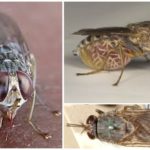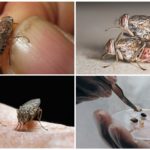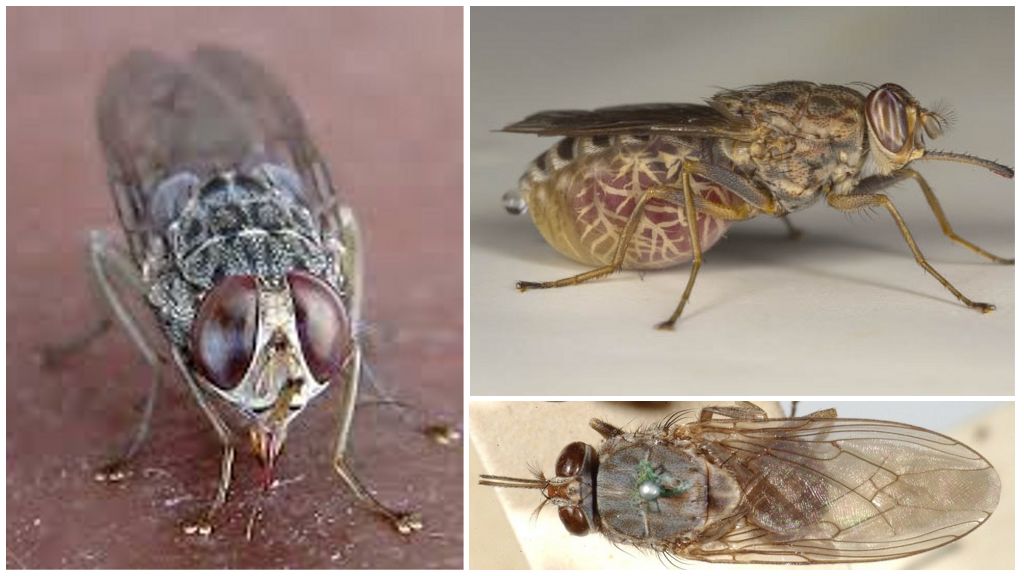Description and photo of tsetse fly
Content
- Tsetse fly
- Breeding tsetse fly
- Consequences of a tsetse fly bite
One of the worst enemies of man and cattle domesticated and at the same time the savior of the wild world of Central Africa - a tsetse fly has 23 species, differing in size. If it were not for these inhabitants of the African savannas, the planet would have been completely deprived of the wild world of Africa. Only the fly ts infecting domestic animals with trypanosomiasis saved the savannah from overgrazing and soil erosion caused by cattle.
What a tsetse fly looks like
The fly is neither impressive in size nor bright in color. This is a nondescript gray insect. The size of the tsetse fly varies from 9 to 14 mm, depending on which species of this dangerous genus a particular insect belongs to.
Tsetse has a reddish-gray chest with 4 longitudinal dark brown stripes, abdomen yellowish above and gray below.
On a note!
If the fly sits quietly, then the overall impression of color: gray. The wings folded on top of each other do not allow us to consider the color of the small abdomen, and the chest is clearly visible.
In all species of tsetse flies, there are 4 features that allow them to be distinguished from the usual two-winged relatives living in Europe:
- The proboscis of the piercing type is directed not downwards, but forward. In the photo of a tsetse fly, taken from above, this sticking forward peak is clearly visible.
- In a quiet state, the wings are folded completely and lie on top of each other. The remaining two signs are easier to see killed by an insect.
- On the wing there is a characteristic pattern of veins: in the middle of the wing, the intersection of the veins forms the silhouette of a butcher's knife.
- Antenna antenna tsetse "fluffy." An awe growing on the main mustache branches on the end.
This characteristic view makes it easy to distinguish the killer fly from all other insects of the African savannah.
Habitat
All tsetse species live in subequatorial and equatorial Africa. In addition to the size of tsetse differ in moisture-loving. Tsetse flies are divided into 3 groups according to habitat:
- Palpalis: lives in coastal areas with rich vegetation;
- Morsitans prefer savanna woods and savannas;
- Fusca: found in the forest zone.
On a note!
The tsetse fly is absent in Russia, the climate here is too cold.
Nutrition
Unlike other less exotic bloodsuckers, which only need blood to start the breeding function, both African sexes feed on blood with both sexes.
The tsetse flies silently to the victim and it is often impossible to notice it before the attack. Because of this feature, the fly was called the "silent killer." Tsetse is attacked mostly on large mammals, which is why they tried to fight it, exterminating wild animals. It has not yet turned out that the insect is not so necessary for this insect:
- Palpalis feeds on the blood of reptiles and humans, only occasionally attacking other mammals;
- Fusca prefers mammals, including humans and cattle;
- Morsitans have the broadest food preferences, which include small birds, domestic animals, bovine mammals, warthogs and humans.
Two species from the last group also divide people into zones. One of the species bites in the face, the other for the legs.
At one meal, the insect drinks as much blood as it weighs itself, swelling twice. There is information that some types of flies Tsetse able to absorb blood twice its own weight. But then they definitely will not fly away.
Interesting!
Initially, the search for victims tsetse produce thermal radiation, because of what they often attack the hoods of cars.
When approaching the victim, the fly "switches" to a search for the emitted carbon dioxide and acetone. Due to this feature, sufficiently effective tsetse fly traps were created. Sensing the victim, the insect becomes very aggressive and persistent. If she was only stunned, she would still try to get to the victim and bite. The aggressor is active only during daytime hours.
Tsetse attacks are not affected only by zebras, which are invisible to the fly because of its striped color.
Life cycle and reproduction
Lifetime adult female about six months.During her life, tsetse mates only once. These flies belong to the viviparous. The female grubs the larva for 1-2 weeks and at a time lays only one. Delayed fly larva immediately buried in wet soil and pupated. The female quickly hides in the shade so as not to dry out. During its life, the female individual lays from 8 to 10 larvae.
Interesting!
The hatching of the adult pupa occurs in a few seconds, and after a minute, the tsetse is ready to fly in search of a partner and food.
Than tsetse dangerous for humans
This insect is dangerous not only for humans, but also for any other mammal that is not immune to the diseases tolerated by these bloodsuckers. Tsetse - do not belong to poisonous flies, but very often they are carriers of the pathogen of sleeping sickness trypanosomes. They can also carry any other diseases that are transmitted through fly bite.
On a note!
Trypanosome is the simplest organism that causes parasitic disease in livestock and people. From domestic animals, only Mosai ponies residing in the valley of the Logone River are resistant to sleeping sickness.
Trypanosome there are several types.Of these, two are dangerous to humans. The hosts of the infection are African antelopes, to whom the parasite does not cause any harm. The bloodsucker absorbs the parasite along with the blood of the antelope. For tsetse trypanosomes are also harmless. These flies are carriers of the disease, but do not die.
The simplest parasite enters the blood of a person through the bite of a tsetse fly, before that shed the blood of an infected animal. Unlike wild African animals that have adapted to trypanosomiasis, in humans these parasites cause a dangerous disease, often resulting in death.
Important!
Trypanosomiasis can also transmit other blood-sucking insects that live in the same area as tsetse.
On the African continent, two species of trypanosome are dangerous to humans. One of them causes Gambian trypanosomiasis, which is common in West Africa and accounts for 95% of all cases of sleeping sickness. The second is “responsible” for the occurrence of the Rhodesian form endemic to Eastern and Southern Africa and occurs only in 5% of cases of the total number of diseases of trypanosomiasis.
Symptoms
At the first stage of the development of the disease, pain in the joints, fever, itching, and headache occur.These symptoms appear 1-3 weeks after being bitten by an infected insect and last for several weeks or months.
If no treatment measures are taken, the second stage begins: coordination is disturbed, consciousness becomes confused, the sleep-wake cycle is disturbed, and limb numbness occurs. If medical assistance was not provided, the person falls into a coma, passing into death.
On a note!
Due to sleep disorders, this disease has been called "sleeping sickness".
Treatment
Developed quite effective methods of treatment of this disease. Medications effectively cope with the destruction of the pathogen, but still do not satisfy the doctors, as they often produce side effects.
The drugs already created during the program of free access of the indigenous population to medical care make it possible to predict the almost complete disappearance of trypanosomiasis diseases by 2020. Wait is not long.











